|
Click pictures for a larger version.
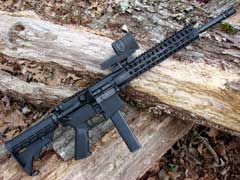
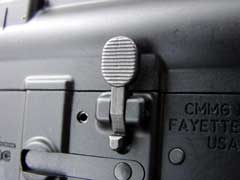

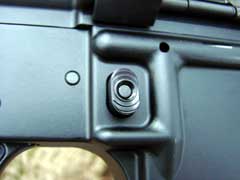
Top to bottom: bolt release, safety, magazine release.


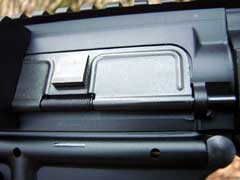
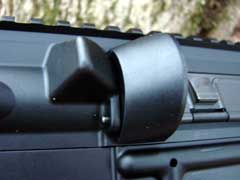
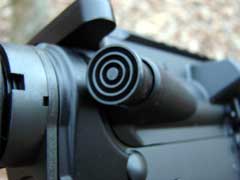
Top to bottom: dust cover, case deflector, forward assist.
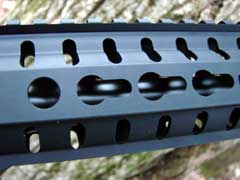
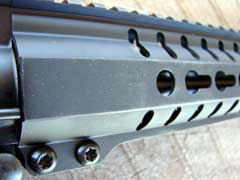
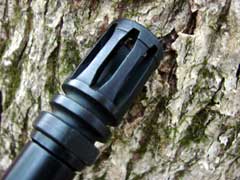
Flash suppressor.

Charging handle.
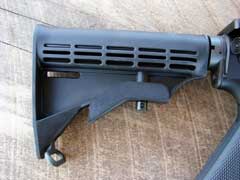
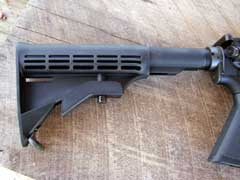
Six-position buttstock.
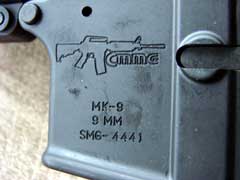
|
|
The AR-15 is the most popular style of rifle
in the US right now, and has been for quite a while. There are
numerous makers of such rifles, with more added each month. It
used to be that I knew of every manufacturer of the AR-15
without looking at any list, but today, I don't even try to keep
track of the number. While the majority of AR-15 rifles are
chambered for the popular 5.56x45mm NATO cartridge, there are
several other chamberings available, as well. One such
chambering that has been available for many years is the 9x19mm
(9mm Luger), and in a carbine, the 9mm is a very useful
cartridge.
CMMG has been in the AR business for a few
years now. My first knowledge of CMMG products was of their
offering a 22 LR conversion for the 5.56mm AR-15.
They now offer complete rifles, and this MK-9 T is one of
their latest carbines. In addition to this semi-automatic MK-9
T, CMMG also offers other versions of a 9mm carbine, including a
short-barreled PDW.
The MK-9 T wears a sixteen inch M-4 profile
barrel, made of 4140 steel. The handguard is their RKM11 KeyMod
free-float aluminum unit. Being of blowback operation, there is
no gas system, but the MK-9 T uses the spring in the stock tube
to return the bolt into battery, just as does a
direct-impingement or gas-piston AR. The buttstock is of the
six-position M4 style, and the flash suppressor is the
closed-bottom birdcage configuration. The receiver is forged of
7075-T6 aluminum, for those who are concerned with such details.
The Mk-9 T comes with one thirty-two round
steel magazines, which feed from a two-column staggered
position. The magazine inserts straight up into the mag well,
and locks into position, using a standard AR-15 style magazine
catch. The magazine well is properly formed into the lower
receiver, instead of just having an after-thought magazine well
block, as is sometimes encountered on other brands.
The MK-9 T weighs in at six pounds, four
ounces on my scale. It balances well, measuring only thirty-two
inches in length, with the buttstock in its shortest position.
The MK-9 T has no sights, but wears a Picatinny top rail on the
upper receiver, which extends also the full length of the
handguard. There is also a short section of rail to attach
elsewhere on the handguard, if desired. The trigger is a
standard milspec unit, but the trigger pull was much better than
what is usually found on a milspec trigger, releasing crisply
with four and three-quarters pounds of resistance, as measured
with my digital trigger pull scale.
I
fired the MK-9 T carbine with several types of 9x19mm ammunition
to check for reliability. I also fired a variety of ammunition
over the chronograph to check velocities, with the results
listed in the chart below. Velocities are listed in
feet-per-second (fps). Bullet weights are listed in grains. JHP
is a jacketed hollowpoint bullet. DPX is a hollow nose
homogenous copper bullet. FP is a frangible, pre-fragmented
flatnose bullet. FMJ is a full metal jacket roundnose bullet. PB
is Cor-Bon Pow’RBall, a specialty
hollowpoint bullet with a polymer insert to insure expansion and
to prevent the hollow nose from clogging with clothing or other
material. XPB is a Barnes homogenous copper hollow-cavity
bullet. Velocities were taken at an elevation of 541 feet above
sea level, with an air temperature of twenty degrees Fahrenheit
and seventy-eight percent humidity. Accuracy was tested at a
distance of fifty yards, firing five-shot groups with the CMMG
carbine rested in a Target Shooting, Inc.
Model 500 rifle rest, with a Leupold 8.5 to 25 power Mark 4
scope attached atop the receiver rail.
| Ammunition |
Bullet Weight |
Velocity |
| WCC
NATO FMJ |
124 |
1233 |
| Buffalo
Bore +P+ JHP |
124 |
1367 |
| Buffalo
Bore +P+ JHP |
115 |
1656 |
| Buffalo
Bore +P JHP |
147 |
1123 |
| Buffalo
Bore +P+ XPB |
95 |
1678 |
| Cor-Bon
+P JHP |
115 |
1357 |
| Cor-Bon
Pow’RBall |
100 |
1414 |
| Cor-Bon
+P DPX |
115 |
1289 |
| Federal
Guard Dog |
105 |
1307 |
| Remington
Home Defense |
124 |
1221 |
| Atomic
+P JHP |
124 |
1444 |
Reliability of the CMMG carbine was
excellent. Every cartridge fed and fired flawlessly, with the
exception of a Remington hollowpoint load that hung up on
feeding early on in the firing of this weapon. Accuracy was very
good. I tested for accuracy at a distance of fifty yards, as
this is a pistol-caliber carbine. Pictured are the smallest and
largest groups fired. Most
ammunition grouped well under the one inch mark at fifty yards
for five-shot groups fired from the bench.
The point can be argued that a pistol-caliber
carbine is very useful in some situations, and makes sense for a
home defense weapon. A 9mm cartridge has much less recoil and
muzzle blast than does the 5.56mm round when fired from a weapon
of equal barrel length and weight. Muzzle blast can be a big
concern when fired inside a building, and muzzle flash can also
be very distracting in low light. The CMMG 9mm carbine offers
low recoil, low muzzle blast, and low muzzle flash, compared to
a 5.56mm carbine. It is much easier to learn to fire effectively
for those who are bothered by recoil and noise.
For
those desiring a 9x19mm carbine, the CMMG MK-9 T is a very good
choice. It is reliable, accurate, easy to fire, and made in the
USA. MSRP as of the date of this review is $1149.95 US. Check
out the entire line of CMMG rifles and accessories online at www.cmmginc.com..
Jeff Quinn
  
Got something to say about this article?
Want to agree (or disagree) with it? Click the following link to
go to the GUNBlast Feedback Page.
|
|
Click pictures for a larger version.

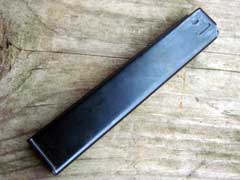
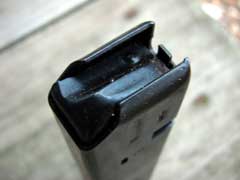
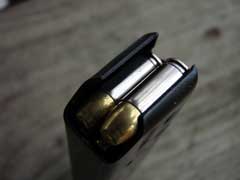
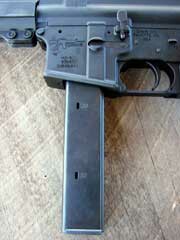
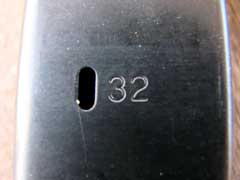
Thirty-two round steel magazine.
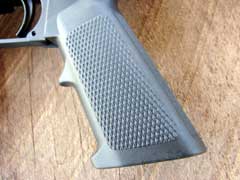
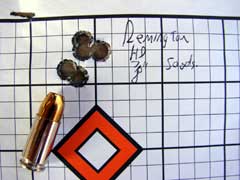
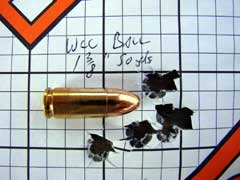
Best & worst groups fired at 50 yards.
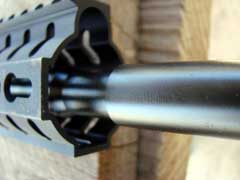
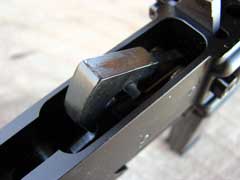
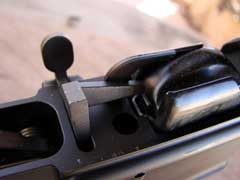


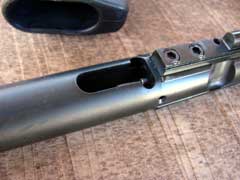

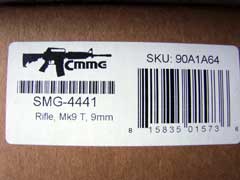
|
![]()